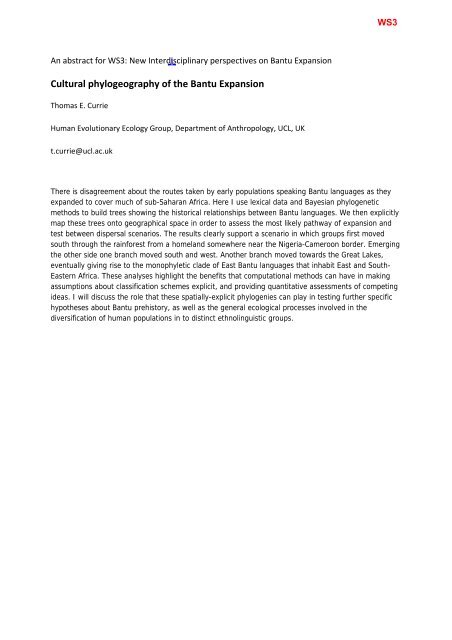here - 5th International Conference on Bantu Languages
here - 5th International Conference on Bantu Languages
here - 5th International Conference on Bantu Languages
Create successful ePaper yourself
Turn your PDF publications into a flip-book with our unique Google optimized e-Paper software.
An abstract for WS3: New Interdisciplinary perspectives <strong>on</strong> <strong>Bantu</strong> Expansi<strong>on</strong><br />
Cultural phylogeography of the <strong>Bantu</strong> Expansi<strong>on</strong><br />
Thomas E. Currie<br />
Human Evoluti<strong>on</strong>ary Ecology Group, Department of Anthropology, UCL, UK<br />
t.currie@ucl.ac.uk<br />
WS3<br />
T<str<strong>on</strong>g>here</str<strong>on</strong>g> is disagreement about the routes taken by early populati<strong>on</strong>s speaking <strong>Bantu</strong> languages as they<br />
expanded to cover much of sub-Saharan Africa. Here I use lexical data and Bayesian phylogenetic<br />
methods to build trees showing the historical relati<strong>on</strong>ships between <strong>Bantu</strong> languages. We then explicitly<br />
map these trees <strong>on</strong>to geographical space in order to assess the most likely pathway of expansi<strong>on</strong> and<br />
test between dispersal scenarios. The results clearly support a scenario in which groups first moved<br />
south through the rainforest from a homeland somew<str<strong>on</strong>g>here</str<strong>on</strong>g> near the Nigeria-Camero<strong>on</strong> border. Emerging<br />
the other side <strong>on</strong>e branch moved south and west. Another branch moved towards the Great Lakes,<br />
eventually giving rise to the m<strong>on</strong>ophyletic clade of East <strong>Bantu</strong> languages that inhabit East and South-<br />
Eastern Africa. These analyses highlight the benefits that computati<strong>on</strong>al methods can have in making<br />
assumpti<strong>on</strong>s about classificati<strong>on</strong> schemes explicit, and providing quantitative assessments of competing<br />
ideas. I will discuss the role that these spatially-explicit phylogenies can play in testing further specific<br />
hypotheses about <strong>Bantu</strong> prehistory, as well as the general ecological processes involved in the<br />
diversificati<strong>on</strong> of human populati<strong>on</strong>s in to distinct ethnolinguistic groups.


